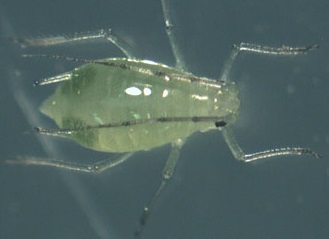
|
|
|
|

|
|||
|
|
|||
Just because we’re experiencing cool weather, don’t become complacent when it comes to aphids. Before the frigid weather occurred in the low desert over the holidays, aphids were beginning to colonize celery plants here at the Ag Center. However, recent temperatures in the Yuma area, and particularly in Wellton and Roll, dropped below 32° F on several nights. Experience has shown that aphid populations tend to slow down significantly under these “cold” desert temperatures. That is essentially what we observed the past week; population growth had stalled out and aphid numbers were very low. However, past experience has also shown us that aphid population growth begins to increase once the weather warms up. Our local weather forecast suggests that temperatures will be in the mid-to-high 60’s with moderate nighttime lows for the next two weeks. Assuming the weather service is correct, these conditions may be ideal for aphid population growth. Green peach aphid population growth tends to increase when temperatures average around 55-57 °F. Because we’ve seen an increase in winged aphids on our yellow sticky traps over the last month, PCAs should be extra vigilant in scouting for aphid colonies. As average temperatures increase later, foxglove aphid may become more abundant (they tend to be more biologically active under warmer temperatures; that is when avg. temps > 60 °F). If the field has been treated with imidacloprid at planting, then chances are you are in pretty good shape. But, continue to monitor as imidacloprid doesn’t generally last all season, particularly in cool, cloudy weather when the plants are not transpiring at a rapid rate. Regardless of whether you find green peach or foxglove aphid the key to effective aphid management with foliar insecticide is to initiate sprays at the time apterous (wingless) aphids begin to colonize. Of course, this requires diligent scouting and sampling. On older lettuce, make sure you thoroughly examine developing heads/hearts. Fortunately, PCAs have alternatives for foliar aphid control. For more information on insecticide alternatives please visit Aphid Management in Desert Produce Crops – 2016. So, keep your eyes open for new aphid colonies and plan according. As Sun Tzu, the ancient Chinese military strategist once said, “Rely not on the likelihood of the enemy’s not coming, but on our own readiness to receive him”. |
|||
| Back | |||
|
For questions or comments on any of the topics please contact Marco Pena at the Yuma Agricultural Center.
|
|||
|
Home |
Cotton | Veggies |
Forages | Grains
| Citrus |
Crop x Crop Insects | Diseases| Weeds | Pesticides | Economics | News | Weather | Research | Photos | Contacts | General Info. Copyright © 2001 University of Arizona, College of Agriculture and Life Sciences Webmaster: Al Fournier (acis@ag.arizona.edu) |
|||

